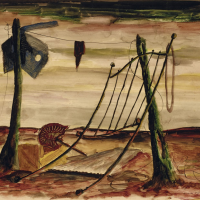56. RUSSELL DRYSDALE

The year of 1941 proved to be a watershed in the development of Russell Drysdales art. Drysdale relinquished a long-held desire to work the land and instead chose to focus exclusively on painting and drawing. He produced his most significant pictures after moving from his familys property near Albury to Sydney in mid-1941. During this time Drysdales unique vision of the Australian landscape and people were set in train. Never the sentimentalist, Drysdale painted an insiders view that depicted the toughness of rural Australia and the resilience of the people who lived there.
Still Life in a Landscape 1941 dates from the same period as a quartet of fine, early works.1 These four paintings are carefully orchestrated combinations of authentic experience and exquisite picture-making skills. Drysdale used strong pictorial elements to reinforce the bond that inextricably connected humans and animals one to the other and to the land.
Still Life in a Landscape has a similarly skilled and dynamic feel. In this rural back block, we are aware of human presence and past activity. The work is composed of two weathered, upright tree trunks with wire tied between them. Sheets of twisted, corrugated iron roofing, remnants of stained cloth and an old iron bedhead are placed around the two vertical anchor points. Drysdales depiction of discarded detritus points to human occupation. The people have used what was available and then moved on.
Drysdales abiding interest in early twentieth-century English and French art is important to Still Life in a Landscape. One thinks of the acclaimed modernist sculptor Henry Moore (18981986) and his monumental hollowed and chiselled carvings. Moore imparted great dignity and bearing to the misshapen human form as did Drysdale with his own elongated, angular figures of Australian itinerant bush workers. Both Drysdale and his friend Peter Purves Smith (1912-1949) had first-hand contact with contemporary English artists, including Moore, through travel and studies they undertook in London and Paris from the late 1930s. The two Australian artists subsequently adopted the Surrealist-inspired idea of melding incongruous motifs into the structure of the surrounding countryside.
The Crow Trap 1941 is another companion work to Still Life in a Landscape. Drysdale had warmed to the motif of the crow trap and the acidic looking yellow-red soil and decided to use it in another context. One cannot look at these early pictures of abandoned farms and scattered debris without also thinking that they may be oblique references to distant theatres of war.
Still Life in a Landscape is a compelling example of Russell Drysdales art. The use of gouache - a fluid, yet opaque medium - was one that Drysdale mastered in addition to watercolour, pen and ink, and oil. Drysdale was an artist intrigued by the incongruities of everyday life and excited by the strange and surreal qualities of the Australian bush.
Footnotes:
1. See Drysdales Man Reading a Newspaper and Man Feeding his Dogs (Queensland Art Gallery | Gallery of Modern Art collection, Brisbane), The Crow Trap (Newcastle Art Gallery collection, New South Wales) and Going to the Pictures (private collection).
Rodney James
Rodney James is an independent art consultant who specialises in valuations, collection management, exhibitions, research and writing, and strategic planning for art galleries and museums.